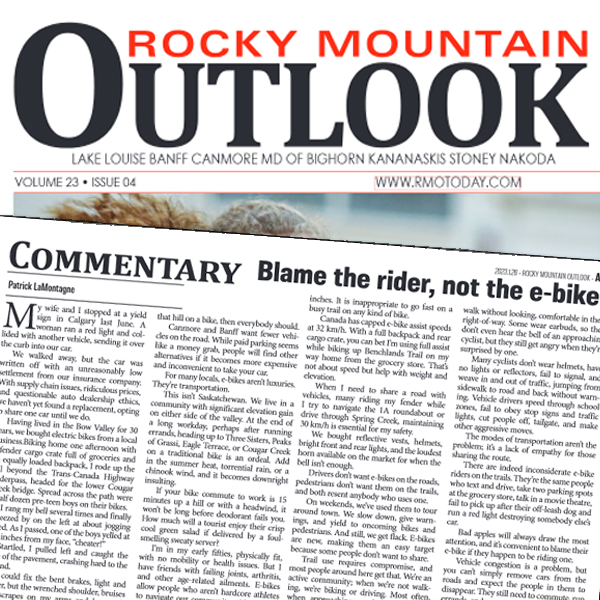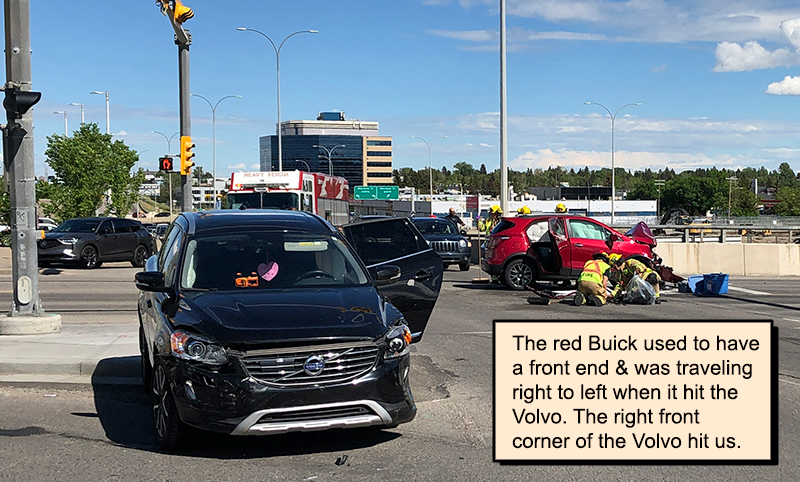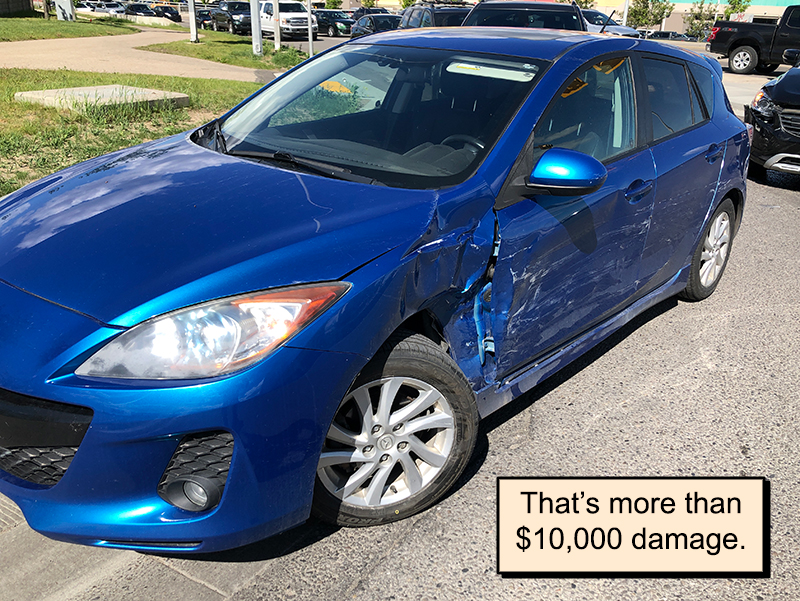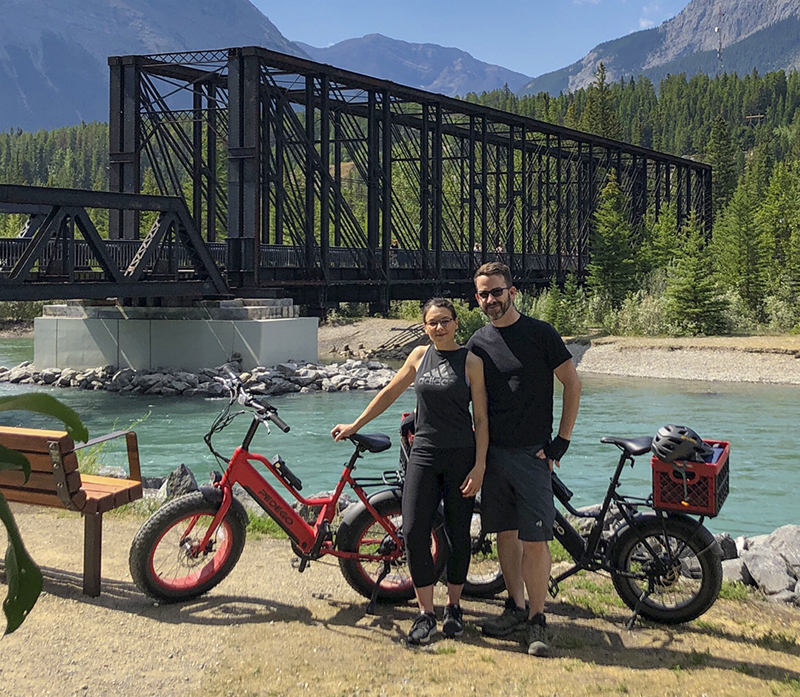
The following is an opinion piece I wrote for the local newspaper, The Rocky Mountain Outlook. I’ve been their cartoonist since its beginning in 2001 and I’ve never missed an issue. This busy tourist-town community is currently involved in a heated conversation surrounding transportation infrastructure. Many municipalities are dealing with these same growing pains, or soon will be. In June last year, my wife and I stopped at a Yield sign in Calgary. A woman ran a red light and collided with another vehicle, sending it over the curb into our car.
In June last year, my wife and I stopped at a Yield sign in Calgary. A woman ran a red light and collided with another vehicle, sending it over the curb into our car.
We walked away, but the car was written off with an unreasonably low settlement from our insurance company. With supply chain issues, ridiculous prices, and questionable auto dealership ethics, we haven’t yet found a replacement, opting to share one car until we do.
Having lived in the Bow Valley for thirty years, we bought electric bikes from a local business.
Biking home one afternoon with a fender cargo crate full of groceries and an equally loaded backpack, I rode up the hill beyond the Hwy 1 underpass, headed for the lower Cougar Creek bridge. Spread across the path were a half dozen pre-teen boys on their bikes.
I rang my bell several times and finally squeezed by on the left at about jogging speed. As I passed, one of the boys yelled at me, inches from my face, “CHEATER!”
Startled, I pulled left and caught the edge of the pavement, crashing hard to the ground.
Later, I could fix the bent brakes, light and fender. However, the wrenched shoulder, bruises and scrapes on my arms and legs took longer to heal. While I had loud, angry words for the kid, we’ve all made stupid choices at that age.
Many ill feelings about e-bikes seem to revolve around what some think, but what that kid said. Some see e-bikes as cheating and resent that if they must strain to climb that hill on a bike, then everybody should.
Canmore and Banff want fewer vehicles on the road. While paid parking seems like a money grab, people will find other alternatives if it becomes more expensive and inconvenient to take your car.
For many locals, e-bikes aren’t luxuries. They’re transportation.
This isn’t Saskatchewan. We live in a community with significant elevation gain on either side of the valley. At the end of a long workday, perhaps after running errands, heading up to Three Sisters, Peaks of Grassi, Eagle Terrace, or Cougar Creek on a traditional bike is an ordeal. Add in the summer heat, torrential rain, or a chinook wind, and it becomes downright insulting.
If your bike commute to work is 15 minutes up a hill or with a headwind, it won’t be long before deodorant fails you. How much will a tourist enjoy their crisp cool green salad if delivered by a foul-smelling sweaty server?
I’m in my early fifties, physically fit, with no mobility or health issues. But I have friends with failing joints, arthritis, and other age-related ailments. E-bikes allow people who aren’t hardcore athletes to navigate our community without forcing them to buy a car, take the bus, or walk everywhere. People don’t have the time, not when many work long hours to afford to live here.
I’ve been an avid trail walker for years. I’ve been startled and grazed by fast-moving cyclists silently passing within inches. It is inappropriate to go fast on a busy trail on any kind of bike.
Canada has capped e-bike assist speeds at 32 km/h.
With a full backpack and rear cargo crate, you can bet I’m using full assist while biking up Benchlands Trail on my way home from the grocery store. That’s not about speed but help with weight and elevation.
When I need to share a road with vehicles, many riding my fender while I try to navigate the 1A roundabout or drive through Spring Creek, maintaining 30 km/h is essential for my safety.
We bought reflective vests, helmets, bright front and rear lights, and the loudest horn available on the market for when the bell isn’t enough.
Drivers don’t want e-bikes on the roads, pedestrians don’t want them on the trails, and both resent anybody who uses one.
On weekends, we’ve used them to tour around town. We slow down, give warnings, and yield to oncoming bikes and pedestrians. And still, we get flack. E-bikes are new, making them an easy target because some people don’t want to share.
Trail use requires compromise, and most people around here get that. We’re an active community; when we’re not walking, we’re biking or driving. Most often, when approaching another trail user, I thumb the bell, and the person moves to the side, saying thank you as I pass; at the same time, I’m offering my thanks for their courtesy. It’s not complicated.
Pedestrians routinely walk three abreast, forcing others into the rough to go around them, or they walk into a crosswalk without looking, comfortable in their right-of-way. Some wear earbuds, so they don’t even hear the bell of an approaching cyclist, but they still get angry when they’re surprised by one.
Many cyclists don’t wear helmets, have no lights or reflectors, fail to signal, and weave in and out of traffic, jumping from sidewalk to road and back without warning.
Vehicle drivers speed through school zones, fail to obey stop signs and traffic lights, cut people off, tailgate, and make other aggressive moves.
The modes of transportation aren’t the problem; it’s a lack of empathy for those sharing the route.
There are indeed inconsiderate e-bike riders on the trails. They’re the same people who text and drive, take two parking spots at the grocery store, talk in a movie theatre, fail to pick up after their off-leash dog and run a red light destroying somebody else’s car.
Bad apples will always draw the most attention, and it’s convenient to blame their e-bike if they happen to be riding one. There’s a guy with a loud aftermarket muffler who races down my street, his bass stereo cranked so loud I can hear it through my closed windows. Should I blame the truck?
Vehicle congestion is a problem, but you can’t simply remove cars from the roads and expect the people in them to disappear. They still need to commute, run errands, and recreate.
Our trails and roads are for all of us, and compromise is a skill that requires practice. Everybody wants problems solved, so long as they don’t have to change.
____
©Patrick LaMontagne 2023


 I could already hear sirens. I don’t know who called 911, but fire, ambulance and police were on scene in a ridiculously short time.
I could already hear sirens. I don’t know who called 911, but fire, ambulance and police were on scene in a ridiculously short time. Shonna’s car was a 2012 Mazda3 GS Sport. It had a leather interior, 154,000km on it and was in immaculate shape. She had just put brand new tires on it the month before. This car was supposed to last another ten years.
Shonna’s car was a 2012 Mazda3 GS Sport. It had a leather interior, 154,000km on it and was in immaculate shape. She had just put brand new tires on it the month before. This car was supposed to last another ten years. So we bought electric bikes, which I’ll write about in another post. A significant investment, but we’ve each put over 300 km on them in just under a month. Shonna takes hers to the gym and commutes to work, and I run most errands on mine; plus, we’re biking for recreation together and enjoying it a great deal. Our busy tourist town has difficult traffic and paid parking, but plenty of bike trails. Now we get everywhere faster than we used to, and our remaining car should last even longer. Provided somebody doesn’t hit us.
So we bought electric bikes, which I’ll write about in another post. A significant investment, but we’ve each put over 300 km on them in just under a month. Shonna takes hers to the gym and commutes to work, and I run most errands on mine; plus, we’re biking for recreation together and enjoying it a great deal. Our busy tourist town has difficult traffic and paid parking, but plenty of bike trails. Now we get everywhere faster than we used to, and our remaining car should last even longer. Provided somebody doesn’t hit us.